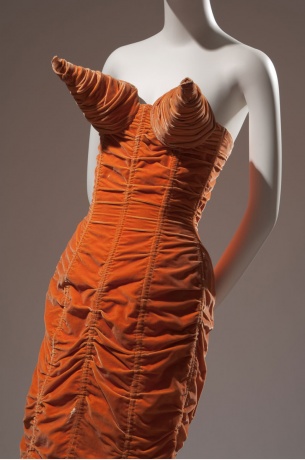by Lynn Yaeger
 Jean Paul Gaultier, orange shirred-velvet dress with cone bust and back lacing, 1984, France, The Museum at FIT. Photo courtesy of the Museum at FIT
Jean Paul Gaultier, orange shirred-velvet dress with cone bust and back lacing, 1984, France, The Museum at FIT. Photo courtesy of the Museum at FIT
What is the most touching display at the Fashion Institute of Technology's "A Queer History of Fashion: From the Closet to the Catwalk"? Is it the wall of fading T-shirts, unwitting souvenirs of heroic demonstrations long past, with slogans like "Safe Sex Is Hot Sex"? Is it Larry Kramer's 1970s Yves Saint Laurent navy safari suit, a physical homage to two gay icons? Or maybe the tailcoat Miguel Adrover fashioned from Quentin Crisp's filthy mattress cover? Or perhaps Marlene Dietrich's trim trouser suit -- the perfect tailleur for a sexually free chanteuse who was once described as "the best-dressed man in Hollywood"?
The exhibition, opening Friday and on view until January 4, 2014, undertakes to tell the story of the intersection between the LGBT community and fashion -- a tale that begins with eighteenth-century "Mollies" (effeminate, cross-dressing "sodomites"), "Macaronis" (foppish fellows whose presence questioned received ideas of masculinity), and "Man-milliners" (guys who worked in the rag trade), all of whom hung out in places like Mother Clap's London molly house, site of a notorious 1726 police raid.
SEE MORE: Top 10 Beauty, Health and Fitness Trends of the Year
Centuries of subterfuge and oppression followed, and years of secret sartorial codes -- Oscar Wilde's green carnation is a famous example -- with the threat of prison or the madhouse haunting every encounter. In the decades before the Stonewall rebellion, designers, by necessity, kept their sexual orientations under, in some cases, literal wraps -- Noël Coward, whose silk dressing gown is on display here, once warned Cecil Beaton: "It is important not to let the public have a loophole to lampoon you . . . I take ruthless stock of myself before the mirror before going out. A polo jumper or an unfortunate tie exposes one to danger."
The exhibition is full of such historical revelations, along with the ensembles created by these geniuses: Who knew back in the day that Christian Dior's final lover, Jacques Benita, was a nightclub singer who performed with a lesbian chanteuse named Suzy Solidor? And how spectacular is it that Rudi Gernreich, scandalous author of, among other innovations, the topless swimsuit, was also a founding member of the Mattachine Society circa 1950 gay rights organization that formed when such associations were illegal?
SEE MORE: Can a Workout Class Kill You?
By the early 1970s, everyone, straight or gay, was sporting shaggy hair and wearing funny clothes, an exuberance that culminates in audacious frocks like the "Lyla Cortez" extravaganza once flaunted by Tahara (aka J.W. Windsor), a charter member of the avant-garde transgender performance troupe the Cockettes. The dress incorporates neckties that originally belonged to Tahara's great-grandfather, and the wearer recalled that gramps would have "rolled over in his grave" if he had seen them transformed into "a dress worn by a man."
As the narrative of sexual and cultural revolution unfolds, once unthinkable styles -- velvet cone bras, leather chaps -- filter into the mainstream. (Gianni Versace remembered, with wonder, that at a certain fete in the 1990s, "There were 200 socialites in bondage!") In a gallery devoted to designs by openly gay creators -- Tom Ford, Thierry Mugler, John Galliano, Alexander McQueen, et al. -- Jean Paul Gaultier's hilarious pink sailor outfit, suitable for a sexy ice cream man who has wandered onto the set of Rainer Werner's Querelle, stands sentinel, a triumphant harbinger of the final installation, where wedding ensembles are on joyous display. If only those Mollies and Macaronis could have witnessed these joyous nuptial ensembles: what a night of mad celebration that would have made at Mother Clap's.
SEE MORE FROM VOGUE:
